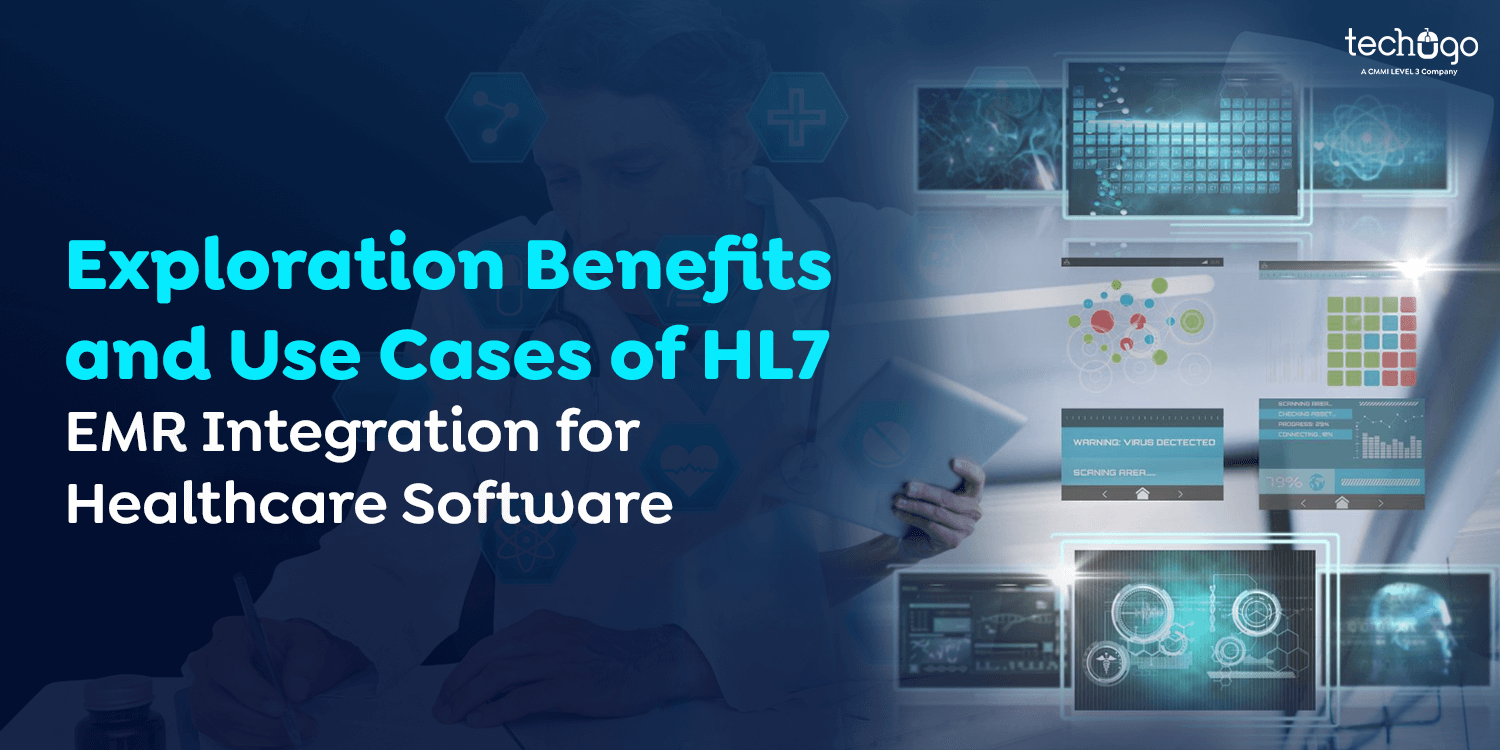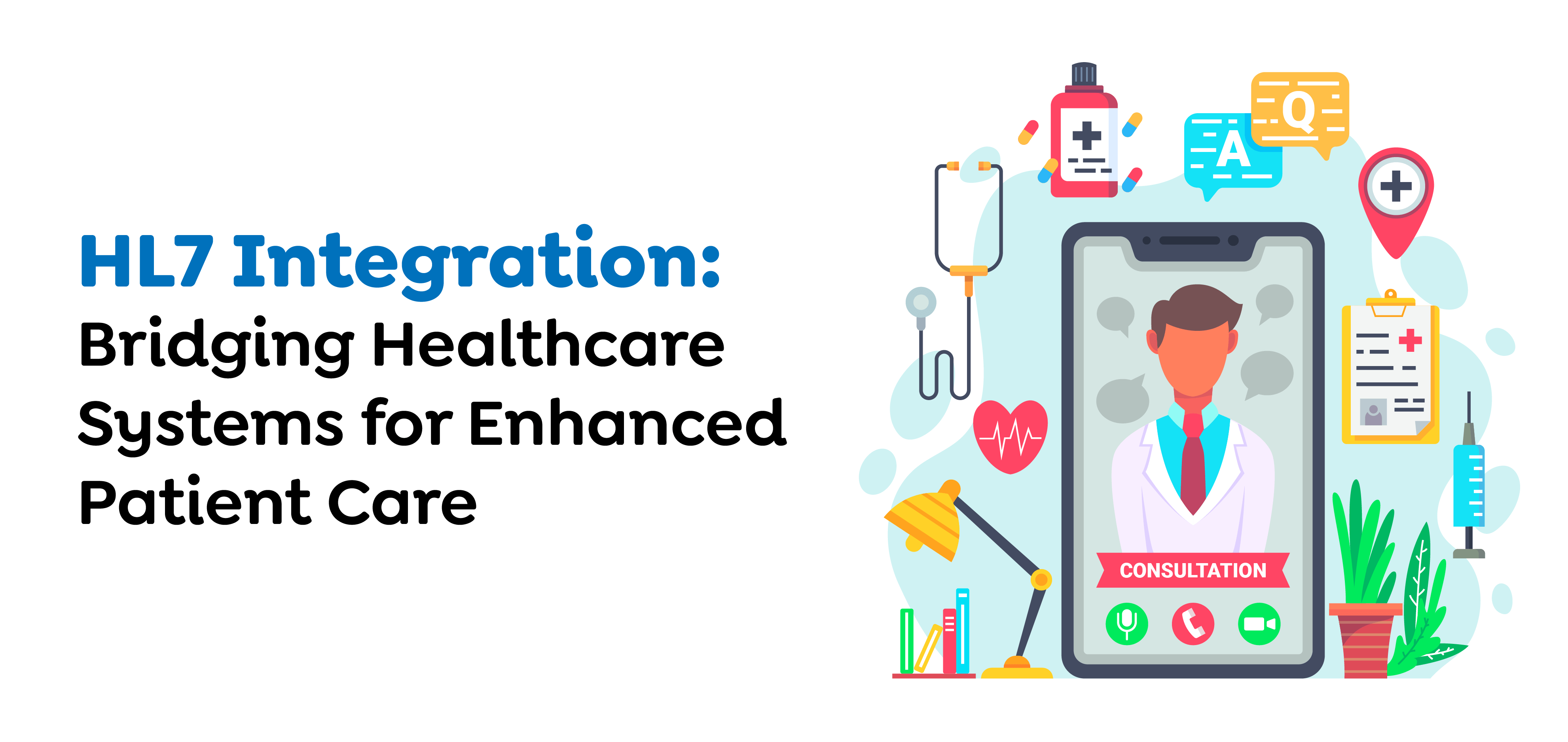Write Us
We are just a call away
[ LET’S TALK AI ]
X
Discover AI-
Powered Solutions
Get ready to explore cutting-edge AI technologies that can transform your workflow!


The main idea is to provide the best healthcare facilities to the patient in this ever-evolving landscape of technology. The smooth transfer of health information has emerged as a foundation for operational effectiveness and enhanced patient treatment. HL7 EMR integration stands at the forefront of this transformation, providing the medical field with a common tongue to connect different IT systems and promote compatibility. In this exhaustive manual, we explore the numerous advantages and applications of HL7 EMR integration, shedding light on its revolutionary effect on contemporary healthcare provision.
With the proliferation of Electronic Health Records (EHR), Laboratory Information Systems (LIS), and other diverse IT systems with technologies like AI & ML, AR & VR , and more, healthcare establishments often struggle with isolated data compartments. These compartments impede the smooth transmission of information crucial for providing top-notch patient care, emphasizing the pressing requirement for standardized communication protocols. Introducing HL7, or Health Level Seven, which has emerged as the universal language for healthcare information systems, guaranteeing interoperability and streamlined data interchange.
Also Read : DoorDash uses Machine Learning and Optimization Models To Enhance Customer Experience: Here’s How!
HL7 integration serves as the cornerstone that links varied healthcare IT systems, enabling a more interconnected and effective healthcare milieu. Whether through Point-to-Point interfaces or HL7 EMR Integration Engines, healthcare organizations can utilize HL7 standards to adapt data structures, manage message flows, and facilitate seamless data interchange without the necessity for numerous individual interfaces. Incorporating HL7 incorporation into healthcare establishments isn’t solely about enhancing data exchange; it’s a tactical step towards creating a more cohesive, effective, and patient-centered healthcare environment.
HL7 integration is propelling a fundamental alteration in healthcare communication and data administration, presenting a plethora of advantages that augment patient treatment, operational effectiveness, and regulatory conformity.
Also Read : Wheel- Virtual Healthcare Platform Raises $50M In Series B Funding Round
HL7 encourages effortless data interchange among various healthcare systems, diminishing data compartments and amplifying system linkages. By enabling smooth correspondence amid healthcare providers, HL7 integration enhances the caliber of patient care via improved information availability.
Precise, instantaneous patient data enhances diagnosis and therapy, while simplifying the care procedure. HL7 criteria guarantee that information remains current at all times, resulting in individualized and prompt patient treatment. Augmented reality data availability backs informed clinical judgments, ultimately enhancing patient results.
Also Read : Top Tips to Consider When Hiring AR Application Development Companies
Efficiently organized processes and diminished administrative loads notably improve operational effectiveness. HL7 integration enhances the utilization of systems, lessens errors in data input, and automates data transactions, leading to swifter and more effective healthcare activities and offerings.
HL7 integration simplifies adherence to healthcare norms and confidentiality statutes, automating compliance documentation and diminishing manual inaccuracies. This nurtures confidence among patients and regulatory bodies, preserving sensitive data efficiently and decreasing the possibility of penalties due to non-adherence.
Integrated data improves comprehensive health perspectives, facilitating thorough examination and endorsing sophisticated analytics. HL7 integration in the development of healthcare software enhances data accessibility and comprehensibility, resulting in accurate predictive models and knowledgeable decision-making.
 Unlocking the Transformative Use Cases of HL7 Integration
Unlocking the Transformative Use Cases of HL7 IntegrationHL7 integration transforms healthcare IT systems, tackling crucial obstacles like fragmented data structures and inconsistent data arrangements. Let’s explore ten revolutionary scenarios of HL7 integration in healthcare:
Integrating Electronic Health Record (EHR) frameworks simplifies the administration of patient information, guaranteeing prompt entry to patient backgrounds, therapy blueprints, and outcomes. HL7 incorporation supports seamless correspondence and data exchange amidst healthcare professionals, amplifying efficiency and elevating patient consequences..
HL7 protocols automate the transfer of laboratory findings directly to Electronic Health Records (EHRs), reducing manual data entry mistakes and hastening the diagnostic procedure. This incorporation ensures swift dispatch of lab results to healthcare professionals, accelerating patient treatment determinations..
The fusion of RIS with PACS optimizes diagnostic imaging protocols, smoothing the transfer of imaging tests and documentation. HL7 incorporation enables radiologists to efficiently retrieve, disseminate, and assess medical visuals, reducing wait times for diagnosis and treatment.
HL7 integration allows pharmacies to seamlessly connect with EHR systems, guaranteeing precise management software of medication requests and improving communication between healthcare providers and pharmacists. This amalgamation enhances patient safety and simplifies the prescription renewal process.
HL7-FHIR integration streamlines the prompt reporting of reportable diseases to public health authorities, enabling real-time monitoring and swift responses to public health crises. This integration bolsters community health by monitoring and addressing public health issues effectively.
HL7 integration grants CDSS access to current patient data from various sources, enabling real-time, evidence-based suggestions to healthcare providers. This integration heightens patient safety and betters treatment outcomes by delivering personalized guidance.
HL7 integration harmonizes appointments across diverse healthcare services, minimizing wait times and averting scheduling conflicts. This integration enhances patient contentment by ensuring a seamless and coordinated patient journey.
HL7 incorporation enables distant discussions, evaluations, and therapy schemes via telemedicine apps facilities, connecting patients with healthcare professionals digitally. This merger heightens healthcare availability and effectiveness by lessening the need for face-to-face appointments.
HL7 integration simplifies the secure and effective interchange of health data among different healthcare institutions through HDI networks. This amalgamation improves the caliber of patient care by guaranteeing healthcare professionals possess access to comprehensive and up-to-date patient information.
HL7 integration simplifies the procedure of submitting, processing, and monitoring medical claims, minimizing mistakes and delays. This integration improves operational efficiency and cash flow by automating billing processes and enhancing claim precision.
Incorporating HL7 into healthcare systems provides top advantages, yet it presents challenges. To ensure a prosperous integration, healthcare organizations must tackle intricacies, data confidentiality worries, interoperability hurdles, and resource constraints. Here are some top practices to surmount these obstacles and attain triumph:
1. Craft a Transparent Integration Strategy: Kick off by outlining a thorough integration plan customized to your organization’s precise needs and aspirations. This strategy should delineate the integration’s scope, schedules, resource allotment, and anticipated results.
2. Collaborate with Proficiency: Team up with a specialized healthcare software development company proficient in HL7 integration. Select a partner with extensive know-how and proficiency in healthcare IT, interoperability benchmarks, and regulatory adherence.
3. Grasp HL7 Standards: Attain a profound comprehension of HL7 standards and their relevance to healthcare systems. Familiarize yourself with various HL7 versions, message categories, segments, and data frameworks to efficiently devise and execute integration solutions.Prioritize Data.
4. Confidentiality and Safety: Guarantee that data privacy and safety take precedence throughout the integration journey. Enforce robust encryption, access management, and compliance protocols to safeguard sensitive healthcare data and adhere to regulations like HIPAA.
5. Explore HL7 Integration Engines: Investigate the potential use of HL7 integration engines or middleware platforms for a more adaptable and effective integration approach. These solutions streamline message routing, data conversion, and interoperability across disparate systems.
6. Conduct Thorough Testing: Execute rigorous testing at every integration phase to detect and rectify any discrepancies or issues. Employ testing environments mirroring real-world scenarios to validate data exchange, message interpretation, and system compatibility.
7. Ensure Continuous Maintenance: Institute proactive maintenance methodologies to guarantee the ongoing reliability and efficiency of HL7 integration components. Regularly update configurations, monitor system health, and address emerging challenges or alterations in requirements.
Incorporating HL7 (Health Level 7) into a healthcare application entails several elements that influence the overall cost calculation. Below are some crucial factors to take into account:
1. HL7 Version Compatibility: The expenditure might fluctuate based on the HL7 version being utilized. Fresher versions could demand more resources for integration owing to supplementary features or modifications in the standard.
2. Integration Scope: The degree to which HL7 is merged into the healthcare application impacts the cost. Integration could encompass data exchange, message parsing, aligning with internal data structures, and ensuring compatibility with other systems.
3. Tailored Requirements: Tailoring to accommodate specific business or workflow demands can heighten the intricacy and expense of integration. This could involve crafting custom HL7 message types, segments, or fields.
4. Data Mapping and Transformation: Bridging data between HL7 standards and the application’s internal data model can be intricate, particularly if the data formats and structures diverge significantly. The exertion required for data transformation and standardization influences the cost.
5. Connecting with Existing Systems: Should the healthcare application require integration with current systems (such as EMR/EHR platforms, laboratory systems, or medical apparatus) using HL7, the complexity and expense of integration may rise due to compatibility issues and the requirement for supplementary interfaces.
6. Security and Regulatory Requirements: Implementing protective measures to safeguard sensitive healthcare data and ensuring adherence to regulations like HIPAA (Health Insurance Portability and Accountability Act) introduces intricacy to the integration process and may demand additional resources.
7. Testing and Verification: Thorough examination and validation are essential to confirm the accuracy of HL7 integration and compliance with quality benchmarks. This encompasses unit examination, integration validation, and validation against HL7 conformity outlines, all of which contribute to the overall expenditure.
8. Training and Assistance: Training personnel on HL7 usage and providing continuous support for troubleshooting and maintenance are ongoing expenses that should be included in the overall estimation.
9. Scalability and Future Growth: Anticipating future scalability needs and potential expansion of HL7 integration to support additional functionalities or data exchanges should be factored in to prevent costly rework in the future.
10. Vendor or Development Partner Expenses: If collaborating with a third-party vendor or development partner for HL7 integration, their fees and charges will impact the overall cost estimation.
By examining these factors and conducting a comprehensive analysis of project requirements, you can formulate a thorough cost estimation for integrating HL7 into your healthcare application. Exploring Some Innovative Integration in Healthcare Other then HL7
Exploring Some Innovative Integration in Healthcare Other then HL7
2. SMART on FHIR:
Also Read : Live Video Api – A Gift From Twitter To Its Users
3. Digital Imaging and Communications in Medicine:
4. IHE (Integrating the Healthcare Enterprise):
Techugo, a top mobile app development company in USA, specializes in providing comprehensive HL7-integrated healthcare software development services, empowering healthcare organizations to achieve interoperability and enhance patient care. Our team of experts combines deep industry knowledge with technical proficiency to deliver tailored solutions that meet the unique needs of each client. With our unwavering commitment to data privacy and security, we ensure that healthcare providers can leverage the full potential of HL7 standards with confidence.
Moreover, HL7 incorporation emerges as a vital strategic necessity for healthcare enterprises aiming to unleash the complete potential of interoperability and boost patient care. By utilizing HL7 benchmarks, entities can streamline data interchange, enhance operational effectiveness, and adhere to regulatory stipulations. Via transformative application instances like EHR assimilation, LIS interaction, and telehealth amenities, HL7 integration transforms healthcare provision, propelling superior outcomes for patients and caregivers alike. With the appropriate strategy and proficiency, a healthcare app development company can navigate HL7 integration obstacles and embark on a journey toward a more interconnected, effective, and patient-focused healthcare framework.
Contact our professionals if you’d like to learn more about how Techugo, a mobile app development company, can help your healthcare business prosper through innovative app development.
Get in touch with our team of experts today to initiate the conversation.
Write Us
sales@techugo.comOr fill this form